
Apium is a genus of about 20 species of flowering plants in the family Apiaceae, with a subcosmopolitan distribution in Europe, Asia, Africa, South America and Australia. They are medium to tall biennials or perennials growing up to 1 m high in the wet soil of marshes and salt marshes, and have pinnate to bipinnate leaves and small white flowers in compound umbels. Some species are edible, notably Apium graveolens, which includes the commercially important vegetables celery, celeriac and Chinese celery. Apium bermejoi from the island of Menorca is one of the rarest plants in Europe, with fewer than 100 individuals left.

Banksia ser. Dryandra is a series of 94 species of shrub to small tree in the plant genus Banksia. It was considered a separate genus named Dryandra until early 2007, when it was merged into Banksia on the basis of extensive molecular and morphological evidence that Banksia was paraphyletic with respect to Dryandra.
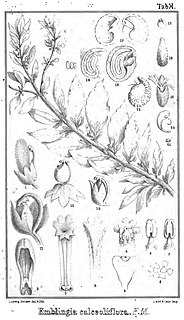
Emblingia is a monospecific plant genus containing the species Emblingia calceoliflora, a herbaceous prostrate subshrub endemic to Western Australia. It has no close relatives, and is now generally placed alone in family Emblingiaceae.
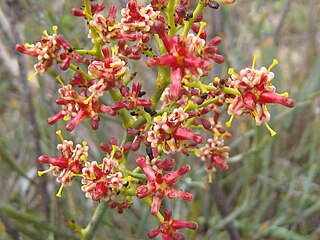
Stirlingia, commonly known as blueboy, is a genus of 7 species in the family Proteaceae, all of which are endemic to Western Australia.
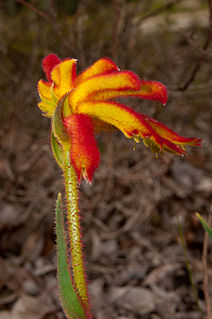
Anigozanthos humilis is a species of Anigozanthos in the family Haemodoraceae. This flowering perennial plant is endemic to Southwest Australia and widespread in its open forests. Common names include catspaw and common catspaw.

Acidonia microcarpa is a species of shrub in the plant family Proteaceae. It is the only species in the genus Acidonia. It is endemic to the south coast of the Southwest Botanic Province of Western Australia.
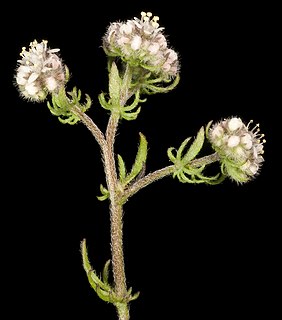
Eremosyne pectinata, the sole species in the genus Eremosyne, is an annual herb endemic to the south coast of Western Australia.

Drosera erythrorhiza, the red ink sundew, is a perennial tuberous species in the carnivorous plant genus Drosera that is endemic to Western Australia. It grows in a rosette and is distinguished from the other species in section Erythrorhiza by its many-flowered cymose inflorescences with up to 50 individual flowers. D. erythrorhiza was first described by John Lindley in his 1839 publication A sketch of the vegetation of the Swan River Colony. In 1992, N. G. Marchant and Allen Lowrie described three new subspecies, thus also creating the autonym D. erythrorhiza subsp. erythrorhiza. The subspecies were separated from this variable species mostly by leaf morphology and distribution.
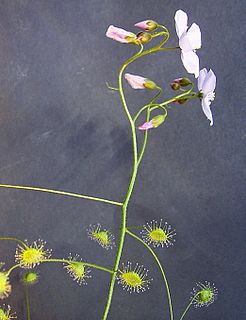
Drosera macrantha, the bridal rainbow, is a scrambling or climbing perennial tuberous species in the carnivorous plant genus Drosera that is endemic to Western Australia. It grows in a variety of habitats, including winter-wet depressions in sandy, loamy, laterite, or quartzite soils. D. macrantha produces small, cup-shaped carnivorous leaves along a long stem that can be 0.16–1.5 m (0.5–4.9 ft) high as it climbs. Its 1 in (2.5 cm) white or pink flowers emerge from June to November, blooming earlier in the more northern range.
Drosera marchantii is an erect perennial tuberous species in the carnivorous plant genus Drosera. It is endemic to Western Australia and grows in a variety of habitats, including swampy areas and hilltops in laterite-silica sand soils. D. marchantii produces small, circular, peltate carnivorous leaves along stiff stems that can be 10–40 cm (4–16 in) high. Its pink flowers emerge from June to October.
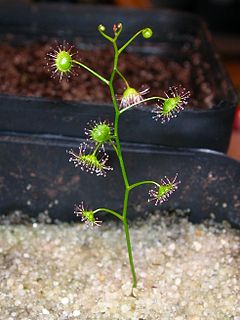
Drosera menziesii, the pink rainbow, is an erect or scrambling perennial tuberous species in the carnivorous plant genus Drosera. It is endemic to Western Australia and grows in a variety of habitats, including winter-wet depressions, swamps, and granite outcrops in clay or peat sand soils or loam. D. menziesii produces small, circular carnivorous leaves along an undulating erect stem that can be .05–1.1 m (0.2–3.6 ft) high. Its pink flowers emerge from July to November.
Drosera neesii, the jewel rainbow is an erect or twining perennial tuberous species in the carnivorous plant genus Drosera. It is endemic to Western Australia and grows near swamps or granite outcrops in sand, clay, or laterite. D. neesii produces small, cup-shaped carnivorous leaves in groups of three along stems that can be 15–60 cm (6–24 in) high. Pink flowers bloom from August to December.

Drosera stricticaulis, the erect sundew, is an erect perennial tuberous species in the carnivorous plant genus Drosera. It is endemic to Western Australia and is found near watercourses and granite outcrops in sandy clay or loam. D. stricticaulis produces small, cup-shaped carnivorous leaves along green, glandular stems that can be 25 cm (10 in) high. Pink flowers bloom from July to October.

Andersonia is a genus of mostly small, evergreen shrubs in the family Ericaceae and is endemic to the Southwest Botanical Province in Western Australia.
Borya is a genus of flowering plants in the family Boryaceae, endemic to Australia.
Needhamiella is a monotypic genus in the family Ericaceae. The sole species, Needhamiella pumilio, is a small shrub that is endemic to Western Australia.

Conothamnus is a genus of flowering plants in the family Myrtaceae and is endemic to the south-west of Western Australia. They are woody shrubs similar to melaleucas but differ in that their leaves are usually arranged in opposite pairs and the maximum number of seeds per fruit is three.
Gunniopsis rubra is a succulent plant in the iceplant family, Aizoaceae. It is endemic to Western Australia.
Rinzia rubra is a plant species of the family Myrtaceae endemic to Western Australia.
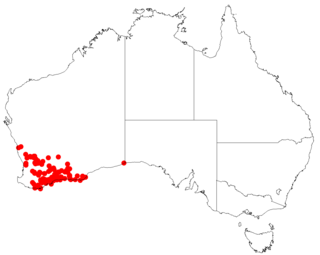
Billardiera coriacea is a twining shrub or climber in the family Pittosporaceae and native to the south-west of Western Australia. It grows on lateritic soils and clay. Its white-cream-yellow, or purple flowers may be seen from May to November.














